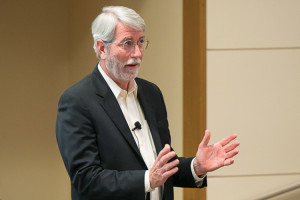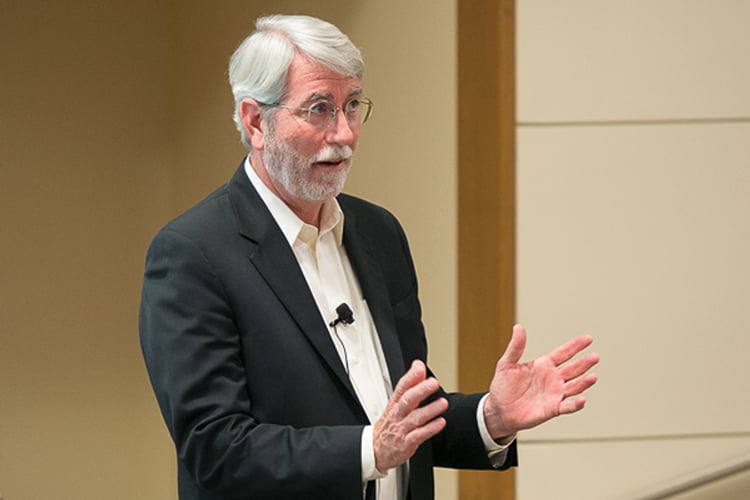
The first meeting of the 46th Faculty Senate took place last Thursday, with a primary focus of discussing proposed changes to the academic course schedule that would standardize class start times with the earliest at 8:30 a.m.
Prior to the scheduling discussion, President John Hennessy and Provost John Etchemendy Ph.D. ’82 provided updates about various projects and administrative matters. These included a summary of the previous year’s fundraising efforts, discussion of the stepping-down of Dean of the School of Engineering Jim Plummer M.S. ’67 Ph.D. ’71, Stanford’s reaccreditation and the construction underway around campus.
Senate Chair David Palumbo-Liu also congratulated Thomas Südhof and Michael Levitt for their recent Nobel Prize awards and David Lobell Ph.D. ’05 and Kevin Boyce for receiving MacArthur fellowships in September.
Scheduling debate
University Registrar Tom Black presented a modified form of the scheduling proposal created by the registrar’s office and Vice Provost for Undergraduate Education Harry Elam.
A central goal of the proposal is simplification of the overall schedule, which is more complex than Stanford’s peer institutions and can be difficult for students to navigate.
Black discussed the need to eliminate overlap in class times by moving courses away from peak times and coordinating scheduling between departments. He stressed that compromise between teachers and students is key.
“We believe that the schedule can fit our curriculum, but we’re going to all have to work together to make that happen,” Black said.
Black believes that the suggested changes will alleviate the need for students to double-book two classes into the same time slot–a practice the University is still considering disallowing. According to the registrar, there are about 1,000 students double-booked in any given quarter.
Elam weighed in, citing Brown University and the University of Chicago–where Black worked before coming to Stanford–as two institutions with more streamlined scheduling systems.
The Senate allowed student representatives to voice their views on the proposal before Black solicited discussion from faculty senators.
Ilya Mouzykantskii ’16, chair of undergraduate life for the ASSU Senate, and ASSU Executive Dan Ashton ’14 thanked the Senate for incorporating student feedback into the changed proposal. They argued against the 8:30 a.m. class start time, mentioning the importance of sleep and saying that the extra half hour of time for class would be more favorable at the end of the day rather than in the morning.
“We believe that by shifting everything down 30 minutes, you still have the same utilization,” Mouzy Kantskii said.
An active debate among the faculty followed, with most of the participants agreeing with the suggestion to make 9 a.m. the earliest class time.
Kathryn Moler ’88 Ph.D. ’95, associate professor of physics and applied physics, worried that students would simply not attend 8:30 a.m. classes. She used her experience teaching a 9 a.m. Physics 61 lecture as an example.
“I can report that by the third or fourth week of the quarter, even the kids who love the class and are very committed to physics are dragging themselves into the classroom,” Moler said.
Marcia Stefanick Ph.D. ’82 P.D. ’84, professor of medicine and of obstetrics and gynecology, pointed out the fact that some students are natural larks and others night owls and argued that Stanford should focus more on sleep hygiene in general.
On the other hand, Paula Moya, associate professor of English, argued that a schedule should include early classes to recognize diversity of habits in students and professors.
“There is a subsection of students who wake up, who are up at 8 a.m. and want to take a class,” Moya said.
Brad Osgood, senior associate dean for student affairs in the School of Engineering, stressed that departments will need to collaborate on scheduling to make any changes successful.
“It’s not as though departments have been rushing to collaborate in the past, but if ever there was a moment for that to happen, it’s now,” Osgood said.
The senate did not take a vote on the proposed schedule changes at the end of the discussion, so the items remain up for consideration.
Development, reaccreditation and construction
At the meeting, Hennessy gave a summary of fundraising in the last year. Stanford raised $931.6 million from over 82,000 families or individual donors. The money was spent on a variety of initiatives.
“A lot of this money went to medicine in our new hospital, but a lot of it also went to issues like financial aid and faculty endowment, which continue to be critical issues for us, especially given a scenario in Washington which is not the most rosy for research universities,” Hennessy said.
Hennessy also addressed the hack of the Stanford network that occurred during the summer and advised faculty to encrypt mobile devices, use complex passwords and avoid the use of older, less secure computers that the University plans to replace.
For his part, Etchemendy announced that the Western Association of Schools and Colleges (WASC) reaccredited Stanford in a process that took six and a half years.
The reaccreditation will last for ten years and requires no report during that period. Etchemendy stated that the terms of the reaccreditation is unheard of.
“I think we’re the first institution probably [during the six-and-a-half years of the review] that has received ten years of accreditation uninterrupted by an interim report,” Etchemendy said.
Etchemendy ended his update by describing the progress of the nearly $500-million central energy facility. The central facility is approximately 40 percent complete, with the electrical substation and hot water distribution system–the reason for construction on roads around campus–each about 60 percent completed.
“When we are done with this, we will have an efficient, sustainable energy system unlike just about any university in the world,” Etchemendy said. “It will be incredible.”
The Faculty Senate will meet again on Oct. 24.
Contact Baker Tilney at satilney ‘at’ stanford.edu.
